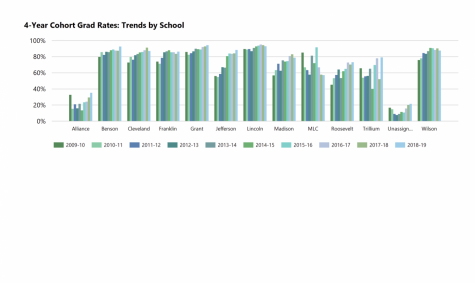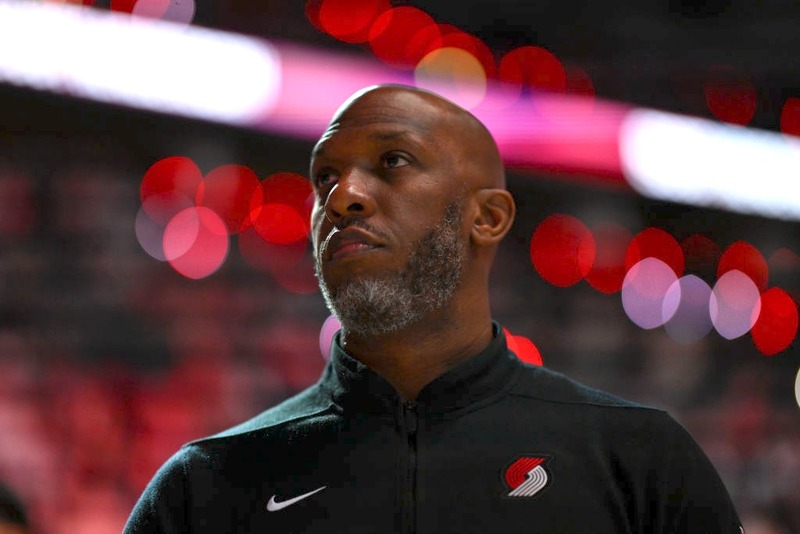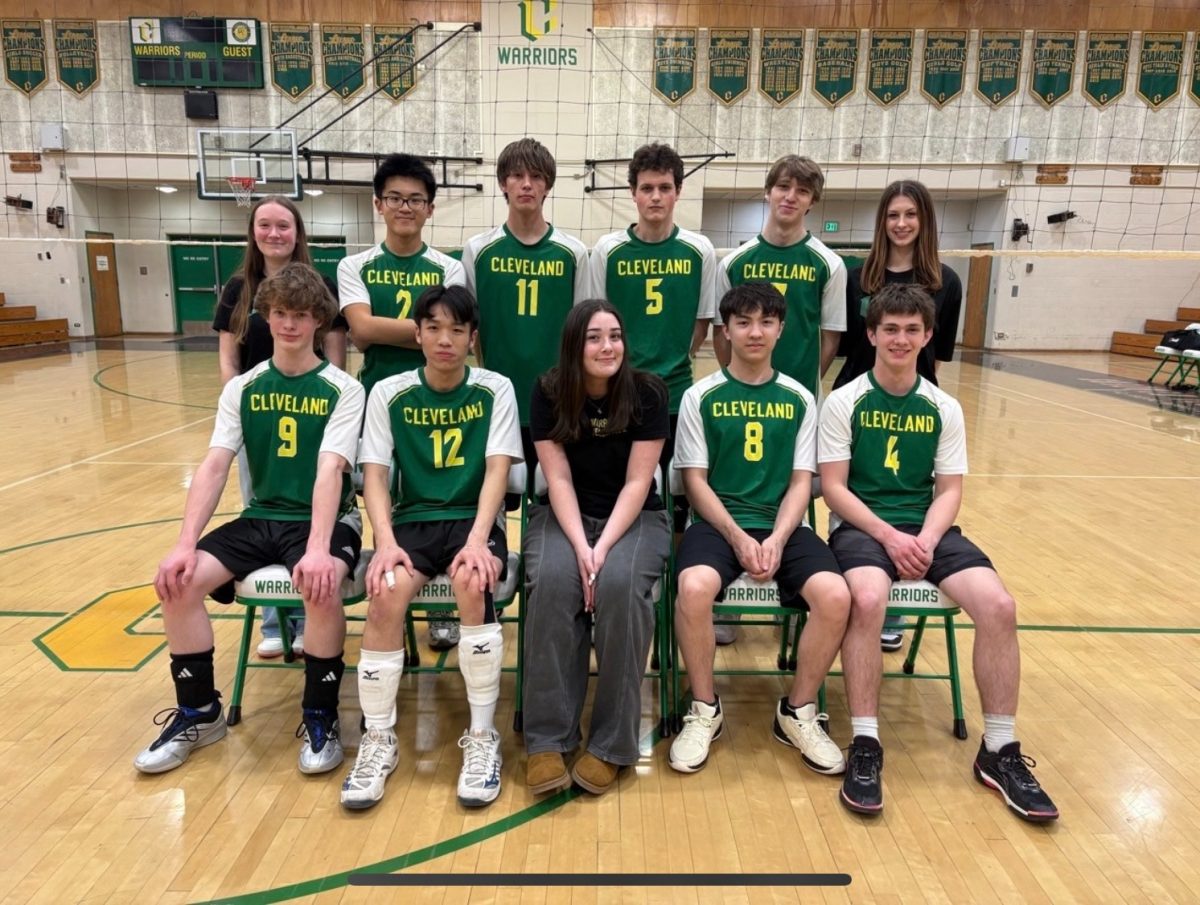Ensuring Graduation For All Students
March 13, 2020

When it comes to a high school’s public image, graduation rates are seen as one of the clearest indicators of success. A school with high grad rates has gotten its students engaged with the curriculum and ready for college. There have been multiple initiatives to get graduation rates rising in Oregon, which has had some of the lowest on-time graduation rates in the country for decades. However, OPB has been running their Class of 2025 project since 2012, following certain students from the class of 2025, who certain Oregon leaders have pledged will have an 100% graduation rate with the right support.
Cleveland’s on-time graduation rate for 2019 was 87 percent, a 19 percent increase from the rate nine years ago. PPS’s was 87 percent (72 percent in 2010), Oregon’s was 80 percent (66.4 percent in 2010), and the USA’s was 84.6 percent (70 percent in 2010). 2019 was Oregon’s highest graduation rate on record. There are several factors that can influence these.
According to a study by the U.S. Department of Education in 2005, rigor of classwork greatly contributes to student preparedness and determines a lot of whether students will complete postsecondary education. The study shows that this has more influence than socioeconomic status does. It presents that the key to keeping students engaged is to maintain high expectations for their work. The problem is striking a balance between appropriately rigorous and challenging courses and work that may be too frustrating for unprepared students who are vulnerable to dropping out. Only 24% of United States high school students said that they were significantly challenged during high school, and raising that percentage is absolutely necessary.
Despite the need for challenging work, it’s also important that students have the tools to handle the rigor of high school before they begin. A Forbes article proposes a long-term solution as making elementary and middle school classes much more substantial and actually educational, in order to prepare students as much as possible before they get to ninth grade. Requiring comprehensive and thoughtful writing pieces is good for getting kids engaged, and so is tutoring (although that is a big advantage of kids who can afford quality help.) This is why certain credit recovery services are too impersonal to actually prepare students for life after high school; there’s nobody working with the student one-on-one for their own experience.
Making the main focus getting kids in a cap and gown regardless of how prepared they are is very counterproductive. A set of standards should be established for graduation requirements and credit recovery programs that require schools to provide comprehensive tutoring to students who are at risk of not graduating, rather than certain credit recovery programs that can be taken online with minimal supervision and are too easy to cheat on. Impersonal programs like barebones, unsupervised online courses can be counterproductive; a student who has motivation problems and is unprepared for the work they’re dealing with needs an actual person to help them with their own specific situation.
Another critical error in helping students graduate on-time is devaluing underprivileged students. Barbara Ritter of the Washington Student Achievement Council wrote that educational institutions make a critical assumption that working class minority students do not come from households rich in social and intellectual resources. “Rather than focusing on the knowledge these students bring to school and using it as a foundation for learning, schools have emphasized what these students lack in terms of the forms of language and knowledge sanctioned by the schools. This emphasis on so-called disadvantages has provided justification for lowered academic expectations and inaccurate portrayals of these children and their families,” Ritter said.
It is very true that services like tutoring, paid workshops and other advantages give upper-class students a significant leg up, and that certain trauma and stress caused by financial disadvantage can impede focus on academics, but the assumption that all working-class students come from households who don’t care or don’t help their children is extremely counterproductive and quite dehumanizing. All students need to be challenged and need to have their academic requirements met by schools, and to dismiss working-class students as unprepared and lower expectations for them is elitist and doesn’t help the improvement of learning conditions.
According to Vice Principal Kristy Mize, Cleveland is implementing additional resources for credit recovery, alongside the summer school, night school, and online course options. “What we’re trying to do is have more options embedded in the school day,” Mize said. Along with their position as regular credits, the classes Film and Lit, Climate Justice, and Women in US History among many others can be used to recover credits for their corresponding academic categories.
Cleveland also has an Attendance Coach and Attendance Team, which can be an improving factor for graduation rates, as attendance and engagement is clearly important to graduation. The team meets twice a month to identify students who are showing as chronically absent, then formulate interventions and plans to help them. The attendance coach helps with school-wide interventions, but also meets with students on regular schedules to make attendance plans with them.
The freshman academy system is a significant effort on the school’s part to prepare students to handle the rest of high school. Having students earn at least six full credits in their first year of high school is strongly correlated to graduation. Each of the academy teams has a release period every other day where they can support freshman who may be struggling in their classes, and this year we’ve added in a sophomore intervention team who can do the same thing for struggling sophomores.
Mize says that she thinks classes have gotten more rigorous for both district and individual reasons, and that the district is making an effort to have the same standards applied to each class. “The district is doing something called the Guaranteed and Viable Curriculum, which is rolled out in science, english, and math, so all ninth-grade algebra classes are all doing the same standards and the same assessments at the same time across the district, and it’s the same with science and is being worked toward in English classes.”
Of course, Cleveland’s status as an IB school also increases rigor, and the IB For All plan in Junior year ensures that students will experience at least three IB classes in that year.













